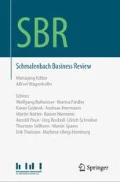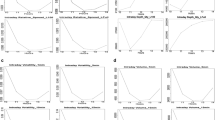Abstract
This paper presents the most extensive analysis of liquidity in the German equity market so far. We examine the evolution of liquidity over time, the determinants of liquidity, and commonality across liquidity measures and countries. We make use of a new publicly available dataset, the Market Microstructure Database Xetra (MMDB-Xetra). We find that liquidity has generally increased over time, and that in times of crisis liquidity is lower and the volatility of liquidity is significantly higher. Commonality in liquidity is highest during the financial crisis. We also find significant commonality between liquidity in the US and the German equity markets.













Similar content being viewed by others
Notes
“Xetra” and “CDAX” are registered trademarks of Deutsche Börse AG.
The CDAX contains all German stocks listed on the Frankfurt Stock Exchange that are admitted to trading on a regulated market.
For more details see Table B1 in Johann et al. (2018).
We recommend any user of the MMDB-Xetra database to apply similar filtering procedures to the raw data.
Trading in Xetra is halted when the price change exceeds a pre-specified threshold. The exact threshold value at which a halt is triggered is not disclosed. After a volatility interruption trading is restarted with a call auction.
We cannot verify when and how the rules have been changed because, as noted above, the exchange does not disclose these rules.
Until September 2009 transactions in Xetra occurred either at the quoted ask or at the quoted bid price. Consequently, the effective spread was equal to the quoted spread in effect immediately before the transaction occurred. However, the effective spread is a contingent measure because an observation is only recorded when a trade occurs. If traders time their trades, i.e. if they tend to trade when the quoted spread is low, the average effective spread will be lower than the average quoted spread. In September 2009 hidden orders were introduced. Hidden orders are large, invisible limit orders. If such an order is placed between the visible best bid and ask prices and is executed, a transaction at a price within the visible quoted spread results. The MiFID pre-trade transparency requirement does not apply to hidden orders because the volume of these orders must be large enough for the large-in-scale waiver to apply.
Results for correlations based on equally-weighted rather than value-weighted averages are shown in the Appendix.
We repeat the analysis using equally weighted averages rather than value-weighted averages. The results can be found in the Appendix.
Our definition of the crisis period follows Bao et al. (2018) and Bessembinder et al. (2017). We tested whether the inclusion of an additional dummy covering the period of the Euro crisis is warranted. To this end we implement the following procedure. We repeated the regression including month-fixed effects instead of the binary variables for the financial crisis and the post-MiFID period. We then plotted the month fixed effects. While there were spikes and elevated variability of the month fixed effects during the 2008–2009 financial crisis for some of the variables of interest (most notably volatility, quoted and effective spreads and price impact) there was no clear pattern during the post-crisis period. We therefore concluded that the independent variables included in the model do a good job at capturing the effect on equity market quality of the Euro crisis.
We have re-estimated all regressions using the US Ted Spread instead of the IR Spread. We still find that lower funding liquidity is associated with higher market liquidity. The coefficients on the Ted Spread in the quoted and effective spread and price impact regressions are still significantly negative while the coefficient in the depth regression is significantly positive.
To further elaborate on this point we re-estimated the model but excluded the VDAX (results not shown). In this alternative specification the coefficients on the financial crisis dummy in the quoted spread and price impact regressions become positive and significant. In the effective spread regression the coefficient becomes positive but insignificant. The coefficient in the depth regression is numerically smaller but remains positive and significant.
Admittedly, we only consider two markets.
Trading hours in Germany changed several times during our sample period.
This might be due to the lower importance of the time difference at the weekly level, and to idiosyncratic variation in liquidity at the daily level which partly cancels out at the weekly level.
The dispersion in trading volume is much larger in the US.
Trading in the US equity market is also fragmented. However, as documented by Angel et al. (2011), fragmentation started earlier in the US.
This regression approach is identical to the one presented by Brockman et al. (2009) in Eq. (3).
In line with Brockman et al. (2009) we use equally-weighted averages. We obtain qualitatively similar results when using value-weighted averages or medians.
An F‑test further confirms that the sum of the three beta coefficients is significantly different from zero.
References
Admati, A.R., and P. Pfleiderer. 1989. Divide and conquer: A theory of intraday and day-of-the-week mean effects. The Review of Financial Studies 2(2):189–223.
Amihud, Y., A. Hameed, W. Kang, and H. Zhang. 2015. The illiquidity premium: International evidence. Journal of Financial Economics 117(2):350–368.
Angel, J., L. Harris, and C. Spatt. 2011. Equity trading in the 21st century. Quarterly Journal of Finance 1:1–51.
Angel, J.J., L.E. Harris, and C.S. Spatt. 2015. Equity trading in the 21st century: An update. The Quarterly Journal of Finance 5(01):1–39.
Bao, J., M. O’Hara, and A. Zhou. 2018. The Volcker rule and corporate bond market-making in times of stress. Journal of Financial Economics 130:95–113.
Bessembinder, H., S. Jacobsen, W. Maxwell, and K. Venkataraman. 2018. Capital commitment and illiquidity in corporate bonds. The Journal of Finance 73:1615–1661. https://doi.org/10.1111/jofi.12694.
Black, F. 1976. Studies of stock price volatility changes. In Proceedings of the 1976 meeting of the business and economic statistics section, 177–181. Washington DC: American Statistical Association.
Bonfiglioli, A., and C.A. Favero. 2005. Explaining co-movements between stock markets: The case of US and Germany. Journal of International Money and Finance 24(8):1299–1316.
Brockman, P., D.Y. Chung, and C. Pérignon. 2009. Commonality in liquidity: A global perspective. Journal of Financial and Quantitative Analysis 44(4):851–882.
Brunnermeier, M.K., and L.H. Pedersen. 2009. Market liquidity and funding liquidity. The Review of Financial Studies 22(6):2201–2238.
Caporale, G.M., L.A. Gil-Alana, and J.C. Orlando. 2016. Linkages between the US and European stock markets: A fractional cointegration approach. International Journal of Finance & Economics 21(2):143–153.
Chordia, T., R. Roll, and A. Subrahmanyam. 2000. Commonality in liquidity. Journal of Financial Economics 56(1):3–28.
Chordia, T., R. Roll, and A. Subrahmanyam. 2001. Market liquidity and trading activity. The Journal of Finance 56(2):501–530.
Copeland, M., and T. Copeland. 1998. Leads, lags, and trading in global markets. Financial Analysts Journal 54(4):70–80.
Frino, A., V. Mollica, and Z. Zhou. 2014. Commonality in liquidity across international borders: Evidence from futures markets. Journal of Futures Markets 34(8):807–818.
Hengelbrock, J., and E. Theissen. 2009. Fourteen at one blow: The market entry of turquoise. SSRN Electronic Journal https://doi.org/10.2139/ssrn.1570646.
Huang, R., and H. Stoll. 1996. Dealer versus auction markets: A paired comparison of execution costs on NASDAQ and the NYSE. Journal of Financial Economics 41(3):313–357.
Jank, S., and M. Wedow. 2015. Sturm und drang in money market funds: When money market funds cease to be narrow. Journal of Financial Stability 16:59–70.
Johann, T., S. Scharnowski, E. Theissen, C. Westheide, and L. Zimmermann. 2018. Market Microstructure Database Xetra. Technical Document.
Karolyi, G.A., K.-H. Lee, and M.A. Van Dijk. 2012. Understanding commonality in liquidity around the world. Journal of Financial Economics 105(1):82–112.
Lakonishok, J., and E. Maberly. 1990. The weekend effect: Trading patterns of individual and institutional investors. The Journal of Finance 45(1):231–243.
Lee, K.-H. 2011. The world price of liquidity risk. Journal of Financial Economics 99(1):136–161.
Newey, W., and K. West. 1987. A simple, positive semi-definite, heteroskedasticity and autocorrelation consistent covariance matrix. Econometrica 55(3):703–708.
Rua, A., and L.C. Nunes. 2009. International comovement of stock market returns: A wavelet analysis. Journal of Empirical Finance 16(4):632–639.
Syllignakis, M.N., and G.P. Kouretas. 2010. German, US and Central and Eastern European stock market integration. Open Economies Review 21(4):607–628.
Zhang, Z., J. Cai, and Y.L. Cheung. 2009. Explaining country and cross-border liquidity commonality in international equity markets. Journal of Futures Markets 29(7):630–652.
Author information
Authors and Affiliations
Corresponding author
Additional information
Acknowledgements
We gratefully acknowledge financial support from the German Science Foundation (DGF) under grant TH 724/6‑1. We thank two anonymous referees for valuable comments.
Appendix
Appendix
Rights and permissions
About this article
Cite this article
Johann, T., Scharnowski, S., Theissen, E. et al. Liquidity in the German Stock Market. Schmalenbach Bus Rev 71, 443–473 (2019). https://doi.org/10.1007/s41464-019-00079-6
Received:
Revised:
Accepted:
Published:
Issue Date:
DOI: https://doi.org/10.1007/s41464-019-00079-6




